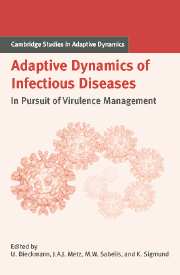Book contents
- Frontmatter
- Contents
- Contributing Authors
- List of Boxes
- Notational Standards
- 1 Introduction
- A Setting the Stage
- B Host Population Structure
- Introduction to Part B
- 6 Variation in Susceptibility: Lessons from an Insect Virus
- 7 Contact Networks and the Evolution of Virulence
- 8 Virulence on the Edge: A Source–Sink Perspective
- C Within-Host Interactions
- D Pathogen–Host Coevolution
- E Multilevel Selection
- F Vaccines and Drugs
- G Perspectives for Virulence Management
- References
- Index
- International Institute for Applied Systems Analysis
6 - Variation in Susceptibility: Lessons from an Insect Virus
Published online by Cambridge University Press: 15 January 2010
- Frontmatter
- Contents
- Contributing Authors
- List of Boxes
- Notational Standards
- 1 Introduction
- A Setting the Stage
- B Host Population Structure
- Introduction to Part B
- 6 Variation in Susceptibility: Lessons from an Insect Virus
- 7 Contact Networks and the Evolution of Virulence
- 8 Virulence on the Edge: A Source–Sink Perspective
- C Within-Host Interactions
- D Pathogen–Host Coevolution
- E Multilevel Selection
- F Vaccines and Drugs
- G Perspectives for Virulence Management
- References
- Index
- International Institute for Applied Systems Analysis
Summary
Introduction
A basic result of Anderson and May's (1982) early work on models of disease in natural (nonhuman) populations is that pathogen fitness is R0 = βN/(α + γ + d), where β is the horizontal transmission rate of the disease, α is the disease-induced mortality rate, d is the background mortality rate, γ is the recovery rate to the immune state, and N is host population density without the disease (see Boxes 2.1 and 2.2). In this model, pathogen strains that maximize β/(α + γ + d) competitively exclude all others. A key insight, however, is that trade-offs among fitness components prevent selection from driving horizontal transmission β to infinity, and mortality α and recovery γ to zero. For the mosquito-vectored rabbit disease myxomatosis, for example, virus strains that kill too rapidly have little chance of being transmitted, because mosquitoes do not bite dead rabbits. On the other hand, strains that kill too slowly produce such low concentrations of virus that they are also unlikely to be transmitted (Fenner 1983). Assuming that the rabbits evolve over a much longer time scale than does the virus, for such a constraint an evolutionarily stable strategy (ESS) exists at the maximum of β/(α + γ + d); compare Boxes 2.1, 2.2, and 5.1.
- Type
- Chapter
- Information
- Adaptive Dynamics of Infectious DiseasesIn Pursuit of Virulence Management, pp. 74 - 84Publisher: Cambridge University PressPrint publication year: 2002
- 6
- Cited by

